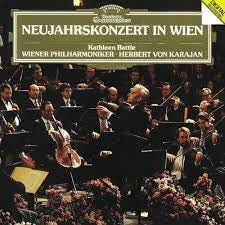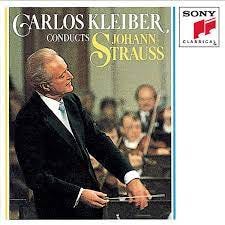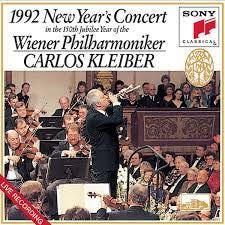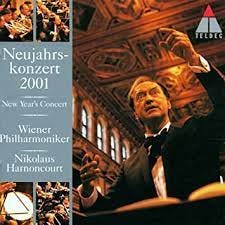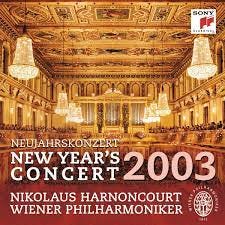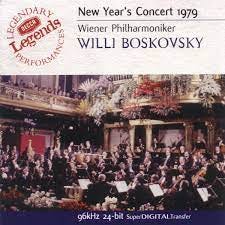The Strauss Family Waltzes and the Best of the Vienna New Year's Concerts
Happy New Year to all! Yes, I know it has been 2022 for a few weeks now already but I am hoping this finds you happy and healthy. Before we return to our top 50 classical recordings of all-time, I would like to take one more opportunity to explore some music that is almost always associated with the coming of a new year. I am referring to the music of the Strauss family of Vienna, including that of the “Waltz King” himself Johann Strauss II (pictured above). The Strauss family was headed by the composer and conductor father Johann Strauss I, and his sons that also became musicians and composers Johann jr (II), Eduard, and Josef. Ultimately, it was Johann II that gained the most fame for his waltzes and operettas.
There are those that doubt the greatness of the music composed by the Strauss family. After all, most of it is dance music created for the entertainment of the Viennese public and is sometimes considered “light” music compared to the more serious compositions of other well-known classical composers. The waltz was the “popular” music of the time. But there can be no doubt that this music has stood the test of time, and has endured because of its charm, inventiveness, and its ability to lift our spirits. Other “light” music composers from the time period, like Jacques Offenbach and Sir Arthur Sullivan (of the famed duo Gilbert and Sullivan) have also endured, but have not reached nearly the immortal status of Johann Strauss II.
The waltz first appeared as an Austro-German dance in ¾ time between 1770 and 1780. It was an adaptation of another type of dance called a Landler. The waltz rapidly became very popular in Europe, and although Vienna is traditionally known as the headquarters of the waltz, it quickly spread to many countries. It was said that in the Vienna of the 1780’s, nothing could stand in the way of the waltz craze that could be seen throughout the city. Indeed, many Viennese danced through the night on certain occasions, and could often be seen at masquerade balls which were very popular.
Some of the greatest names in classical music composed music for the dance, including Mozart, Haydn, Schubert, Chopin, Brahms, Dvorak, and Richard Strauss (not related to Johann Strauss II). But the first major exponent of the waltz was Johann Strauss the elder. Some thought the waltz immoral, in fact some more puritanical voices claimed that it would lead to destitution and disgrace. But there was no stopping the growth in the waltz’s popularity. If you sampled Viennese homes from the mid-1800’s, you likely would have found Strauss waltzes being played in every home. Most of those waltzes would have been composed by Johann II, who wrote more than 200 waltzes. You would have heard them on the street, in cafes, in the theaters, and at parties and balls. It is truly “feel good” music, and it became deeply entrenched in Austro-German culture.
Strauss the elder is certainly to be credited with bringing the waltz music to a wide audience, both composing his own new music and by conducting it with his own orchestra. This was more than just background music, and even some of the fiercest music critics of the age had to admit to its appealing qualities. What is more, Strauss the elder was important in building the actual orchestra that played his music. In the 1840’s, orchestras were generally of very low quality and didn’t play often enough to become virtuosic. Strauss the elder changed that by hand picking the best musicians and promising that they would be regularly employed. Further, he drilled and trained them to be the best. Strauss is sometimes regarded as the first real conductor in a modern sense, because he was very much a despot when it came to his orchestra. His personality and image were larger than the music itself, and he very much demanded things be done his way.
Johann Strauss sr. when he was young formed a group with a friend by the name of Josef Lanner, and the agreement was Strauss and his band would perform and Lanner would compose. Lanner himself was a very fine composer, lyrical, original, and was making wonderful music. The story goes that Strauss himself decided to try his hand at conducting, and then allegedly Lanner incorporated part of a Strauss melody in one his own compositions, which enraged Strauss. The two men actually came to blows over it, and decided to end their arrangement. Although Lanner now lives in the shadow of the Strauss family, his music is often still performed in Vienna.
Strauss sr. turned it into a big business by being able to compose music to be performed at a large beer hall in Vienna. He composed not only waltzes, but polkas, quadrilles, galops, and marches. His Radetzky March is still played often today. He took his orchestra on tour, and they were THE ticket to have in the day. Everywhere they toured, they triumphed.
Back home Johann jr. was born in 1825. Father was not much interested in being a parent, but on one thing he was clear. None of his children were to become professional musicians. Johann jr. discovered he had musical talent, but feared his father’s dictate so much that he had to take lessons secretly.
Scandalously, father took up with another woman and had to move out of the house. However difficult it may have been on his mother, this was fortunate for Johann jr. By the time of his father’s death in 1849, Johann jr. was already well on his way to becoming an established professional musician to his father’s chagrin. In fact, it was all the talk in Vienna when, at the age of 19, Johann jr. decided to actually compete against his father. He engaged a concert hall, and a review the next morning in a Vienna paper said, “Good night Lanner. Good evening, Father Strauss. Good morning, son Strauss.” Eventually the son and father reconciled, and when the father died, junior took over his father’s orchestra. Johann jr. would come to lead no fewer than six different orchestras at the same time, and it became a huge business to say the least.
In the 1860’s, Johann II turned to mostly composing. During this time he composed his most beloved waltzes, marches and polkas which included: Accelerations, Perpetuum Mobile, Emperor Waltz, Tales from the Vienna Woods, Voices of Spring, Vienna Blood, Artist’s Life, Morning Papers, and of course On the beautiful blue Danube. These works are more than mere dance numbers, but deserve to be counted among the greatest masterpieces and tone poems in classical music. They are sophisticated, sometimes elaborate, always melodic, and carry an optimism that is palpable. Brahms became a huge fan of Strauss II, as did Berlioz and Richard Strauss.
Strauss II also became a prolific composer for the stage, writing many operettas. However, only two of them became mainstays, Die Fledermaus (The Bat) and Die Ziegeunerbaron (The Gypsy Baron). They contain some of his most brilliant music, and my own personal favorite the Overture to Waldmeister.
Johann Strauss II came to the United States in 1872, when he was invited to participate in the Peace Jubilee in Boston. He was to be paid an enormous amount of money ---$100,000---to conduct fourteen performances of his Blue Danube waltz. As it turns out, Strauss ended up conducting all the performances with a gigantic orchestra of over a thousand musicians. While the musical result was less than encouraging, it still did a lot to enhance his reputation around the world. Soon he became a millionaire, and was truly the “Waltz King”.
Where have you heard Strauss waltzes? Most likely in many places such as movies, TV commercials, or on the radio. But where the Strauss family music is revered and celebrated annually is on New Year’s in Vienna. There have been New Year’s concerts in Vienna for almost 200 years, but the tradition of playing Strauss every New Year’s Eve and New Year’s Day began in 1939 with the Austrian conductor Clemens Krauss. It was planned as a benefit concert for the war effort, and was approved by the Nazi gauleiter of Austria Baldur von Schirach. The Nazi roots of the New Year’s concert was soon forgotten, and the concert performed by the Vienna Philharmonic Orchestra has subsequently been performed every year from 1941 until the present. It was Krauss that used the music of Johann Strauss II in that first concert, and the tradition took hold.
The annual New Year’s Day concert is played by the Vienna Philharmonic in the Golden Hall of the Musikverein, the legendary orchestral hall in Vienna. Eventually other traditions came along, such as specific encore pieces being played every year in specific order. The concerts have always been a mix of waltzes, polkas, galops, and marches, but since 1958 the last three pieces played have always been a polka schnell, followed by the Blue Danube waltz, and then the Radetzky March to end the concert. The other numbers played are generally chosen by the conductor. Because Vienna became associated so strongly with the best New Year’s celebrations, radio and television began picking up the concert broadcasts. Eventually it was picked up by television stations all over the world, and in 1985 the PBS networks in the United States started broadcasting the annual concert as part of their Great Performances series. Viewers in the USA may recall that Howard Cronkite hosted for many years, followed by Julie Andrews, and currently it is hosted by Hugh Bonneville of Downton Abbey fame. The concerts are now televised all over the world.
Tickets to attend the concerts in person are among the most difficult to come by for any concert in the world. Many Austrian families have a claim on the seats and they are passed down from generation to generation. Other seats are put up for a lottery selection to those that have made an application to attend. Demand is extremely high.
For many years, from 1955 through 1979, the concerts were conducted by the Willi Boskovsky, the concertmaster (first violin) of the Vienna Philharmonic. Beginning in 1980, the orchestra decided to have a conductor for the concerts, and it appointed conductor Lorin Maazel (Maazel was born in France to American parents, and was raised primarily in the United States). Maazel conducted the concerts from 1980 through 1986. In 1987, the Vienna Philharmonic decided to choose a different conductor each year for the New Year’s concerts, and that has certainly added color and intrigue over the years. The 1987 concert in particular has garnered legendary status because it was led by the famous conductor Herbert von Karajan in his only New Year’s appearance two years before his death.
Commercial recordings of the annual concert began in 1979, with Boskovsky’s final year at the helm. Since then it has been recorded for commercial release every year (even in 2021 when there was no audience present due to the Covid pandemic), and all the major classical recording labels have been involved. It has become something of a tradition for many to collect these recordings each year.
But like anything, some concerts have been better than others, and some of the recordings are better than others. So now I would like to list for you my recommendations for the top 6 New Year’s Vienna concert recordings. If you listen to these recordings, you will have a very good understanding of the music of the Strauss family, and why it is so loved around the world.
It is important to note that the Vienna Philharmonic is a self-governing body and does not have a permanent resident conductor.
1. 1987 - Vienna Philharmonic conducted by Herbert von Karajan
Despite the fact that this recording does not bring us the entire concert, but only selections, it still remains one of the finest New Year’s concerts. This was legendary Austrian conductor Herbert von Karajan’s only time to lead the concert, and he made the most of the opportunity. The sound is warm and ravishing from the vaunted Vienna strings sounding particularly shining and radiant. Karajan leads some of the most well-known pieces including the Die Fledermaus Overture, the Music of the Spheres and Delirien waltzes (both by brother Josef Strauss), Voices of Spring (with the young soprano Kathleen Battle singing), and of course the traditional Blue Danube and Radetzky March. There is something very special about this concert, and the orchestra plays magnificently for Karajan. Not to be missed.
2. 1989 – Vienna Philharmonic conducted by Carlos Kleiber
3. 1992 – Vienna Philharmonic conducted by Carlos Kleiber
The semi-recluse Carlos Kleiber came out to conduct the 1989 and 1992 versions of the New Year’s concert, and what events they were. Having achieved almost mythical status, any Kleiber appearance became something special. Kleiber had a distinct way with music, I would describe it as direct and to the point but with gracefulness and feeling. He was gifted with uncanny musical insights and analytical abilities. Also from Austria, the Viennese adored him. Many of his contemporary musicians and conductors consider him the greatest conductor of the 20th century, some say of all time. However, he was elusive. He did not care to take on a permanent post of a major symphony orchestra, and he disliked recording very much. In his 74 years, he conducted only 96 concerts and about 400 operatic performances. His vision was inspiring to the musicians he was leading, and that is part of what makes these two appearances in 1989 and 1992 so worth seeking out. Highlights include Accelerations Waltz, Die Fledermaus Overture, Artist’s Life, Eljen A. Magyar Fast Polka, Voices of Spring, Csardas from Ritter Pazman, The Blue Danube, Die Ziguenerbaron Overture, A Thousand and One Nights, Village Swallows from Austria, and of course the Radetzky March. These concerts were among the first recorded by Sony, and although the sound is clean and clear, they lack some warmth and depth.
4. 2001 – Vienna Philharmonic conducted by Nikolaus Harnoncourt
5. 2003 – Vienna Philharmonic conducted by Nikolaus Harnoncourt
Nikolaus Harnoncourt, yet another Austrian, was a pioneer in historically informed performances of music from the baroque and classical period. A cellist in the Vienna Symphony Orchestra from 1952 to 1969. Meanwhile, in 1953, he founded the period instrument ensemble Concentus Musicus Wien with his wife Alice. His work with this ensemble made him very well known by the 1970’s. He recorded a lot of music from Bach to Monteverdi, from Haydn to Beethoven. Eventually he broadened his conducting interests, and delved into late classical and romantic era composers. He would eventually come to conduct all the major orchestras in Europe, though he eschewed conducting in the United States. He formed a wonderful working alliance with the Vienna Philharmonic along the way, and they invited him to conduct the New Year’s concerts really at the height of Harnoncourt’s renown. He had recently conducted a critically acclaimed set of the Beethoven symphonies with the Chamber Orchestra of Europe.
Harnoncourt’s style was based on his research of the composer and being true to the score, as he was a historian and intellectual. But he was not a fundamentalist in this regard, he also conducted with his own vision and interpretation. The 2001 recording in particular is perhaps one of the best recorded concerts in its history, and you can hear a lot of details. I enjoy that Josef Lanner features prominently in the 2001 concert, and that Weber and Brahms are also featured in the 2003 concert. Harnoncourt was imaginative and never boring, and you can tell that the players love playing under his direction. I only wish he had conducted more of the New Year’s concerts before his death in 2016.
5. 1979 – Vienna Philharmonic conducted by Willi Boskovsky
As previously noted, Boskovsky was the Vienna Philharmonic concertmaster for many, many years and conducted the New Year’s concerts for 25 years. However, 1979 was the first year it was recorded live, in this case by Decca records. You can that the engineers had not yet perfected their approach to capturing the sound of this concert. However, it is astonishingly vivid and clear. This was a landmark recording because it was the first time Decca had used their digital recording system, and it was very well received. The performance is full of life and spirit, and since Boskovsky was yet another Austrian conductor, the audience loves him. His style was in the same manner as Johann Strauss I himself, meaning he would direct the orchestra while playing the violin. Favorites include Wine, Women, and Song, von Suppe’s The Beautiful Galatea Overture, the Pizzicato Polka, At the Hunt polka, Light of Heart polka, and the usual encores.
6. 2021 – Vienna Philharmonic conducted by Riccardo Muti
Since 1990, no other conductor has led the New Year’s concert as many times as Riccardo Muti. He conducted the concert for the sixth time in 2021. Muti is an interesting character. The current music director of the Chicago Symphony Orchestra, and a prolific recording artist, he is the only conductor on my list that is not Austrian. However, Muti’s Italian heritage is not far away from Austria. At times seen as somewhat dour and serious, conducting the New Year’s concerts in Vienna has always brought out the best in him and indeed many smiles. Over the years, he has performed and recorded many, many times with the Vienna Philharmonic. But this performance from 2021 is taken from the middle of the Covid pandemic, and for that reason there is no audience present in the Musikverein. Given that fact, it is a remarkable statement on the importance of music in lifting the spirits of a broken world. The traditional New Year’s address given by the conductor before the Blue Danube has never been so poignant and heartfelt. The entire concert is really outstanding, Muti features several composers other than the Strauss family, along with several Strauss standbys such as Emperor Waltz, Ohne Sorgen! Polka schnell, Voices of Spring, Im Krapfenwald’l, and of course the usual encores. It is a performance given as a gift of hope to the world.
_____________
Schonberg, Harold C. The Lives of the Great Composers (Revised Edition). Pp. 318-325. W. W. Norton & Company, New York. 1981.
https://en.wikipedia.org/wiki/Nikolaus_Harnoncourt
https://en.wikipedia.org/wiki/Willi_Boskovsky
https://en.wikipedia.org/wiki/Vienna_New_Year's_Concert



